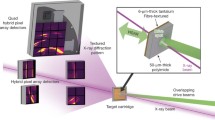Abstract
A mechanism responsible for the high speed shear relaxation immediately behind shock fronts is suggested. The shear stress generated by the shock front causes the growth of two-dimensional defects in the crystal lattice, known as stacking faults (SF). Increasing the SF concentration and area leads to the absorption of impact energy. A breach of the lattice symmetry due to the SF presence causes an additional shift in peaks of the x-ray diffraction pattern obtained from the shock compressed material. Thus pulse x-ray diffraction is the only method that experimentally measures both the dilatational and deviatoric components of the deformation, which takes place during shock wave passage.
Similar content being viewed by others
References
Altshuler LV, Egorov LA, Nitochkina EV, Orekin YK (1981) X-ray diffraction investigation of the structure of shock-compressed aluminum. Sov Phys JETP 54:359–361
Asay JR, Chhabildas LC (1981) Determination of the shear strength of shock compressed 6061-T6 aluminum. In: Meyers MA, Murr LE (eds) Shock Waves and High Strain Rate Phenomena in Metals. Plenum Pub Corp, New York pp 417–431
Cowan GR (1965) Shock deformation and the limiting shear strength of metals. Trans Met Soc AIME 233:1120–1130
Egorov LA, Nitochkina EV, Orekin YK (1972) Registration of debyegram of aluminum compressed by a shock wave. JETP Lett 16:4–6
Epstein GN (1980) Structure of the explosion deformed metals (Russ). Metallurgia Moscow
Hirth JP, Lothe J (1968) Theory of dislocations. McGraw-Hill, New York
Jamet E, Bauer F (1978) Analyse radiacrystallographique de la deformation de la structure crystalline de chlorure de sodiem somise a une compression par onde de choc. Comp des Milieux Denses sous Hautes Pressions Dynamique, Paris pp 104–118
Johnson Q, Mitchell AC, Keeler RN, Evans L (1970) X-ray diffraction during shock wave compression. Phys rev Lett 25:1099–1101
Johnson Q, Mitchell AC, Evans L (1972) X-ray diffraction study of single crystal undergoing shock wave compression. Appl Phys Lett 21:29–30
Kondo K, Sawaoka A (1980) Flash X-ray diffraction study of LiF under shock compressing. In: High Pressure Science and Technology. Plenum New York pp905–911
Kormer SB (1968) Optical study of the characteristics of shock compressed condensed dielectrics. Sov Phys Uspekhi 11:229–254
Marsh SP (1980) LASL shock Hugoniot data. Univ Calif Press, Berkely
Miller F, Shulte E (1978) Shock wave compression of NaCl single crystal by flash X-ray diffraction. Z Naturforsch 33a:918–923
Nabarro FRN (1987) Theory of crystal dislocations. Dover Pub Inc New-York
Podurets AM, Barenboim AI, Pul VV, Trunin RF (1988) X-ray diffraction in shock compressed materials. In: Transactions of the IV All-Union Conf Detonat (In Russian). OIHF Chemogolovka pp162–167
Venables JA (1960) Deformation twining in face-Centered cubic metals. Prog Metal Phys 9:379–396
Warren BE (1959) X-ray studies of deformed metals. Prog Metal Phys 8:147–165
Zaretsky EB, Mogilevsky Pa, Kanel GI, Fortov VE (1991a) Installation for x-ray diffraction studies of shock compressed materials. Teplofizika Vysokikh Temperatur 29:1002–1008
Zaretsky EB, Mogilevsky PA, Kanel GI, Fortov VE (1991b) X-ray diffraction study of phase transition mechanism in shock compressed monocrystal KCl. Doklady Akademii Nauk SSR 318:111–115
Author information
Authors and Affiliations
Additional information
This article was processed using Springer-Verlag TEX Shock Waves macro package 1.0 and the AMS fonts, developed by the American Mathematical Society.
Rights and permissions
About this article
Cite this article
Zaretsky, E.B. X-Ray diffraction evidence for the role of stacking faults in plastic deformation of solids under shock loading. Shock Waves 2, 113–116 (1992). https://doi.org/10.1007/BF01415899
Received:
Accepted:
Issue Date:
DOI: https://doi.org/10.1007/BF01415899




